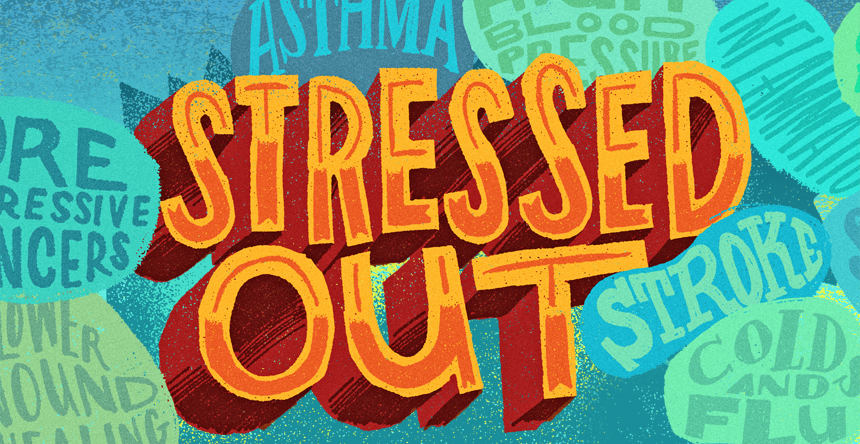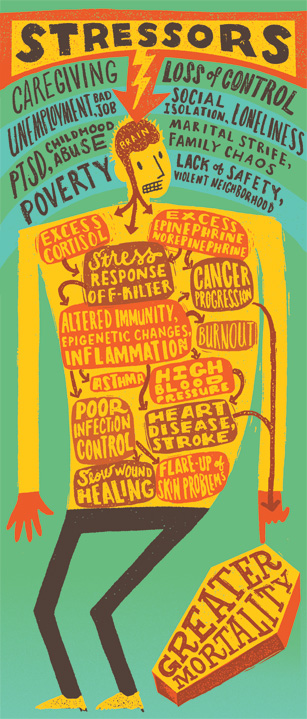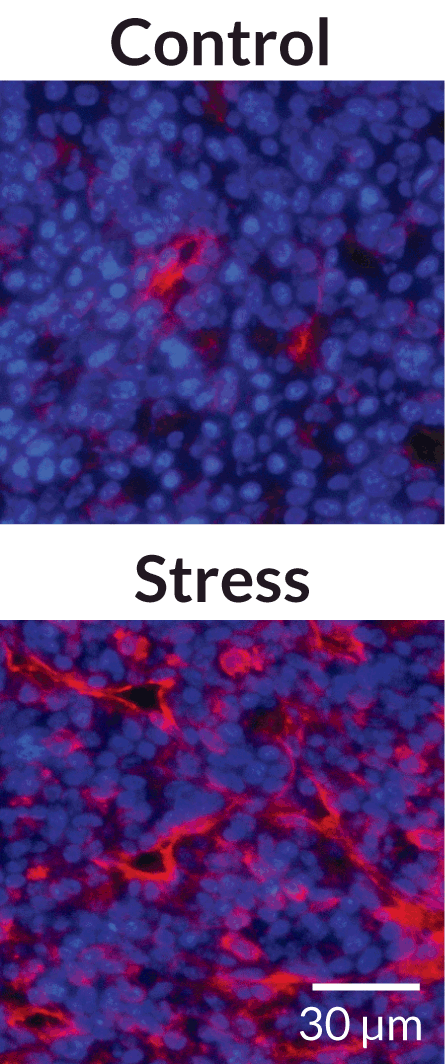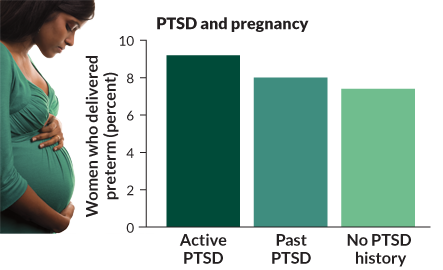Chronic stress can wreak havoc on the body
Finding a way to chill may benefit long-term health

STRESS MESS Scientists are figuring out how chronic stress — from recurring pain, unemployment, poverty, caring for a sick spouse and other sources — puts a burden on the body.
Jeff Rogers
Ask anybody — stress is bad news. The negative view of stress has been expressed so consistently that the concept is now built into our vernacular, which is spiced with advice on avoiding it: Take it easy. Calm down. Chill.
Of course, a good case of stress comes in handy during an encounter with a grizzly bear on a hiking trail. In that situation, a stress reaction delivers a burst of hormones that revs up the heart and sharpens attention. This automatic response has served humans well throughout evolution, improving our odds of seeing another day.
Problems arise, however, when stress becomes a feature of daily life. Chronic stress is the kind that comes from recurring pain, post-traumatic memories, unemployment, family tension, poverty, childhood abuse, caring for a sick spouse or just living in a sketchy neighborhood. Nonstop, low-grade stress contributes directly to physical deterioration, adding to the risk of heart attack, stroke, infection and asthma. Even recovery from cancer becomes harder.
Scientists have now identified many of the biological factors linking stress to these medical problems. The evidence centers on nagging inflammation and genetic twists that steer cells off a healthy course, resulting in immune changes that allow ailments to take hold or worsen.
Despite the bad rap stress has acquired throughout history, researchers have only recently been able to convince others that it’s dangerous. “It’s taken much more seriously now,” says Janice Kiecolt-Glaser, a clinical psychologist at Ohio State University in Columbus. “In the 1980s, we were still in the dark ages on this stuff.”
Stress research gained traction with a master stroke of health science called the Whitehall Study, in which British researchers showed that stressed workers were suffering ill effects. Scientists have since described how a stressed brain triggers rampant hormone release, which leads to imbalanced immunity and long-term physical wear and tear. Those effects take a toll quite apart from the anxiety and other psychological challenges that stressed individuals deal with day to day.
First come the stressors
“Take This Job and Shove It” was a No. 1 country hit in 1977. Perhaps songwriter David Allan Coe had heard about the Whitehall Study, because around that time scientists in London were finding out that some guys might live longer if they found other work.

The researchers were tapping a national health registry and work records to get vital information on thousands of male British civil servants.
Men in the lowest-level jobs were more than three times as likely to die of heart problems during the long-term study as men in more lucrative positions, the researchers found. Those low on the job ladder smoked more, had higher blood pressure, exercised less and reported less leisure-time activity on average than the higher-ups. No wonder they died sooner, or so it seemed.
But even when the researchers removed extra variables by comparing the low-tier men with those in higher-level jobs who were similar in weight, smoking status and other factors, the lower-achieving men still died sooner and had more heart attacks. The Whitehall researchers concluded by 1978 that the health disparity “can be only partly explained by the established coronary risk factors.” That left hereditary differences and factors not accounted for — such as stress. Women were added to the Whitehall Study in the mid-1980s, and by 2003, the study had linked heart disease in both sexes with high job demands and little latitude in decision making.
Other research has supported these work-stress findings. Some forms of work are naturally stressful, and sure enough, they carry health risks. Police are 21 times as likely to die of a heart attack while in an altercation with a suspect as they would be normally. It figures that exertion poses a risk, but cardiac mortality risk was up only sevenfold during physical training. The stress of a dangerous encounter made the difference, researchers concluded in BMJ in 2014.
Some people bring their own stress to the table, such as Type A personalities — those hard-driving, competitive types. Researchers at San Carlos University in Madrid identified 150 adults who had survived a stroke and asked them to fill out a questionnaire. Stroke survivors’ neighbors of a similar age then answered the same questions. The stroke patients scored lower on self-assessed quality of life. And they scored twice as high on Type A behavior measurements and were nearly four times as likely to have had a stressful experience in the preceding year.
Even when the researchers accounted for differences in smoking, diabetes, alcohol use, energy drink consumption and other conditions and habits, the stroke survivors were more likely to have a Type A profile or a high-stress history. The study appeared in 2012 in the Journal of Neurology, Neurosurgery & Psychiatry.
In laboratory settings, researchers can zero in on particular stressors and their effects on health measures, such as how well the immune system responds to injury. In 2005, Kiecolt-Glaser and her microbiologist husband Ronald Glaser enlisted 42 healthy couples to test how interpersonal stress might affect wound healing. On two separate occasions, the couples came to a clinic in the morning, ate breakfast, gave a blood sample and endured some mild discomfort as a nurse used a medical device to raise a small suction blister wound on one arm. Next the couples underwent either positive social support counseling about their marriage or, at a separate visit, were led into a discussion of their marital disagreements.
The scientists checked the wounds in the following days. Couples healed in a median of five days after friendly counseling but took six days after a session about marital conflicts. When the conflict sessions were split into couples who got confrontational versus those who were more easygoing, the hostile couples took a median of two days longer to heal, the researchers reported in JAMA Psychiatry.
“Minor, everyday stressors have an impact on immune responses,” Kiecolt-Glaser says. Chronic stress can also diminish the immune protection a person garners from a vaccine, raise blood pressure and even enable a case of herpes to flare up.
Isolation’s impact
Some forms of chronic stress don’t involve argument or debate, but they are just as damaging.
High on the list is loneliness.
Social species, from fruit flies to Homo sapiens, fare poorly when isolated, says John Cacioppo, a social neuroscientist at the University of Chicago. Lonely people are more apt to have high blood pressure, fragmented sleep and diminished immunity. Older lonely people are more likely to have deteriorating lung health than those with better social support, research shows.
This makes sense from an evolutionary perspective, Cacioppo says. “Early in our history as a species, we survived and prospered by banding together — in couples, in families, in tribes — to provide mutual protection and assistance. The aversive feeling of loneliness serves to prompt us to renew the connections we need,” he and psychologist Stephanie Cacioppo, his wife, wrote in Social & Personality Psychology Compass in 2014. “Finding oneself on the social perimeter is not just sad but also dangerous.”Caregivers frequently wind up on the frayed edge of their social circle because they spend a lot of time with an ill spouse or parent. Caregivers are often lonely even though they aren’t alone, and they become chronically stressed. They show poor immune defense against infectious diseases.
To make matters worse, immunity weakens naturally with age. “By superimposing stress on the aging of the immune system, you accelerate those effects,” says Kathi Heffner, a psychologist at the University of Rochester in New York.
Loneliness and other chronic stressors are particularly detrimental in people with cancer. The major cause of death from cancer is metastasis, the disease’s spread within the body. A test in mice with breast cancer showed that stress — induced by putting the animals in a confined space for two hours a day for 20 days — increased the likelihood of metastasis by 30-fold.
In a study of 68 women with ovarian cancer, higher levels of the stress hormone norepinephrine were found in the tumors of patients with advanced or aggressive cancers than in women with cancers that were more under control. Notably, the researchers also found that patients with good social support had less norepinephrine in their tumors, as reported in Brain, Behavior, and Immunity in 2011.
Norepinephrine and its cousin epinephrine, also known as adrenaline, are stress hormones that act like fuel for some cancers, including prostate cancer. They help tumors build the blood vessels they need to nourish themselves and grow.
The stress-related hormones don’t seem to cause cancer, says Anil Sood, a gynecologic oncologist at M.D. Anderson Cancer Center in Houston. “It’s more about cancer growth progression,” he says. “That’s where the data seem to be more convincing.”
The benefits of fending off stress showed up in women awaiting tests to see whether their pelvic growths were cancerous or benign. Those who reported good social support had more immune attack cells directed at these masses, Sood and his colleagues reported in 2005.
Changing cell behavior
A century ago, Harvard’s Walter Bradford Cannon introduced the concept of “fight or flight” to summarize the two best options prehistoric people faced upon running into trouble. But only recently has research revealed the microscopic fallout of having stress hormones switched on day after day.
Stress reactions start in the brain, the master interpreter of events occurring around us. A stressed brain trips excessive release of epinephrine and norepinephrine plus the stress hormone cortisol. Like all hormones, these molecules exert their effects by binding to receptor proteins in and on cells, changing the cells’ behavior. The hiker fleeing the bear does so because receptors by the millions are suddenly telling cells to kick into gear. The pulse rate quickens. That’s also how epinephrine helps resuscitate a person in cardiac arrest.But an everyday, steady release of stress hormones trips other switches throughout the body in a drumbeat that steadily poisons the system — spreading biological changes like wildfire.
For instance, epinephrine and norepinephrine normally keep a leash on NF-kappa-B, a master regulator of immune processes that is also considered an agent of inflammation. But overproduction of epinephrine and norepinephrine desensitizes their receptors. This bogs down signaling and their ability to rein in NF-kappa-B and inflammation.
Chronic stress also disrupts cortisol’s effects. In a 2014 study in Psychoneuroendocrinology, researchers found that declining self-esteem in people age 64 and older coincided with increased cortisol levels in the saliva. That’s a dicey prospect since cortisol is normally tightly controlled. It affects blood pressure, metabolism, blood sugar levels, bone health, behavior and immune reactions such as inflammation.
When cortisol latches onto a receptor on an immune cell, it tones down that cell. It’s basically an off-switch for inflammation, which is why people with inflamed joints sometimes get relief from a shot of cortisone, a cortisol mimic.
But too much cortisol exposure is no good. “When you bathe immune cells in glucocorticoids [cortisol] in a dish, they shut down their receptors,” says Heffner, the Rochester psychologist.
Researchers tested the effect of disrupted cortisol signaling in 276 healthy volunteers, taking note of those who had previously reported a recent major stressful life event. Blood tests showed the stressed individuals had more muted cortisol receptors. “The receptors on immune cells … become less sticky and less available to cortisol,” says study coauthor Sheldon Cohen, a psychologist at Carnegie Mellon University in Pittsburgh. Without proper cortisol signaling, inflammation ran unchecked.
The researchers then quarantined all of the volunteers and exposed them to one of two common cold viruses. After five days, the stressed people with muted receptors were twice as likely to develop a cold as nonstressed volunteers, the researchers reported in the Proceedings of the National Academy of Sciences in 2012.
In a separate study, Cohen tested parents of children with cancer, a high-stress group. “They show receptor resistance, even though they aren’t making a lot of cortisol anymore,” he says.
The body is just trying to right the ship. When too much cortisol is turned loose too frequently, the body “adapts” by muting receptors, Heffner explains. “The cells stop paying attention.”
This receptor muting appears tied to professional burnout, a condition marked by emotional exhaustion, cynicism and a sense of diminished accomplishment. A review in the June 2013 International Journal of Occupational Medicine and Environmental Health notes that burnout also involves a decreased capacity to cope with stress and with less of the awakening response. Scientists are still trying to nail down the links between off-kilter cortisol signaling and burnout.
Inflammation’s green light
Taking the brakes off inflammation underlies many of the ailments that crop up in population studies of chronic stress.
A prime concern, from the Whitehall Study and others, has been heart disease. Inflammatory immune cells form part of the plaques that clutter the coronary arteries that nourish the heart muscle. Normally, fibrous caps hold these plaques together, preventing problems. But too much inflammation can weaken the caps, a 2011 study in pigs showed. If a cap ruptures and a plaque is dislodged, the vascular equivalent of a fire alarm goes off, triggering a blood clot to form instantly at the rupture site. If the clot blocks a coronary artery, hello heart attack.
One way to measure inflammation is by tracking blood levels of interleukin-6, an immune signaling protein. A 2013 Whitehall analysis in the Canadian Medical Association Journal tracked IL-6 for five years in more than 3,000 adults. People with at least two high IL-6 readings over that time were more likely to have some sort of heart problem as people with consistently lower IL-6.Also in Whitehall, scientists linked high IL-6 levels and another inflammatory marker, called C-reactive protein, with stress and diabetes. People who grew up facing stress because of poor socioeconomic conditions faced a doubled risk of type 2 diabetes as adults. The authors attributed one-fourth of the added risk to chronically elevated inflammation.
Other work ties high IL-6 to a history of childhood abuse and to the strains of caregiving. A 2013 review revealed that while IL-6 levels rise naturally with age, 75-year-old caregivers have the IL-6 levels of a 90-year-old.
Scientists are now digging deeper, sorting through changes in gene activity that underlie inflammation and receptor shutdown. For example, childhood stress might get embedded in immune cells called macrophages through epigenetic changes — alterations that affect the activity levels of genes without changing the underlying DNA. Psychologist Gregory Miller of Northwestern University in Evanston, Ill., suggests that these changes can endow the macrophages with pro-inflammatory tendencies that later foster chronic diseases.
That line of research circles back to NF-kappa-B, the inflammatory molecule. When Miller and colleagues tested immune cells from 33 adults caring for a family member with brain cancer and compared those with cells from 47 people without such a major stressor, the caregivers’ cells had increased activity in genes tied to NF-kappa-B.
The negatives of chronic stress and inflammation extend down to the chromosomal level in other ways. When inflammatory genes get activated in people with high stress, their telomeres get shortened. Telomeres are the tips that hold chromosomes together — like the plastic ends of shoelaces — and prevent unraveling. Eli Puterman, a health psychologist at the University of California, San Francisco, and his colleagues monitored 239 healthy women for a year to test their telomere length in response to stressors. Each major life stressor encountered in that time was matched by a substantial shortening of telomeres in white blood cells, Puterman and collaborators reported in Molecular Psychiatry in June. On the plus side, the telomere shrinkage stopped when the women improved their health behaviors by emphasizing good nutrition, exercise and sleep.
Why stress affects some people more than others is unclear. So researchers are examining variant forms of the genes encoding the receptors for stress hormones and for immune signaling proteins. A gene called Adcyap1, which encodes pituitary adenylate cyclase-activating polypeptide, also seems tied to the stress responses. Researchers writing in Nature in 2011 linked a variant form of the peptide’s receptor with PTSD in women. Other work ties the variant form of this receptor to a greater startle reflex in kids and women. And epigenetic changes and variant forms of the receptor’s gene were associated with stress from exposure to violence and appear linked to asthma risk in Puerto Rican children, a 2013 study found.
Researchers are now pursuing treatments for stress (see “Six ways to beat chronic stress“). Some studies show that antidepression and antianxiety medications can help as can beta-blocker drugs. The lingering question is whether improved social support and self-help practices can halt the physical ravages of stress, as with those women whose telomeres stopped shrinking. “My hunch is it might depend on the level of exposure people have over time,” says Bert Uchino, a psychologist at the University of Utah in Salt Lake City.
Chronic stress ultimately predicts disease, mainly via inflammation, Kiecolt-Glaser and colleagues wrote in Social & Personality Psychology Compass in 2011. “People who have supportive, close relationships have lower levels of systemic inflammation compared to people who have cold, unsupportive and conflict-ridden relationships.”
Asthma and adversity
Throughout much of history, asthma was considered a nervous condition. Hippocrates counseled a patient with asthma “to guard himself against his own anger.” Well into the 20th century, the condition was dubbed “asthma nervosa.”

Adding chronic stress to this mix might tip the scales toward asthma, even before birth, research shows. Researchers measured inner-city pregnant women’s exposure to stress and then tested the umbilical cord blood of their newborns. Most of the 557 women in the analysis were in low-income black families. Greater maternal stress during gestation was linked to higher cord-blood levels of interleukin-8, an inflammatory protein. Stressors included domestic violence, lack of money, poor neighborhood safety and housing uncertainties, says Rosalind Wright, a pulmonary physician at Mount Sinai Hospital in New York City. The report appeared in the American Journal of Respiratory and Critical Care Medicine in 2010.
In another inner-city study, wheezing, which is linked with asthma risk, was tripled in children up to age 2 whose moms reported living in highly stressed conditions before and after giving birth. “I think of stress as just under the surface there, pushing the immune system in certain directions,” Wright says. “When individuals are hit by another asthma trigger such as air pollution, they just fall off the cliff.”
The asthma rates in inner cities have not been well-defined. A recent report from Johns Hopkins University researchers using nationwide census data found that while more urban kids than nonurban indeed have asthma — 12.9 percent versus 10.6 percent — that difference may be better explained by race and ethnicity, and in some cases household poverty, than city living.
But urban stress factors show up consistently in asthma work. In an analysis of 25 inner-city schools appearing in the January Pediatric Pulmonology, children whose caregivers deemed their neighborhoods unsafe had twice the odds of having asthma as did kids living in safer neighborhoods. A similar effect was found in children in urban Salvador, Brazil, who were exposed to excessive violence.
Air pollution, tobacco smoke and other factors affect a person’s asthma risk, Wright says. “Stress does that, too. It’s not just affecting your head.”
This article appeared in the March 7, 2015, issue of Science News with the headline, “The mess that is stress.”









